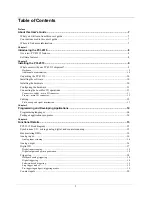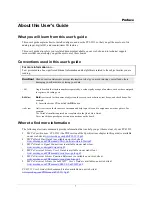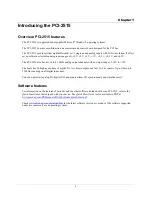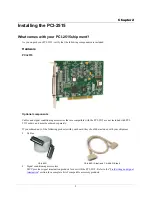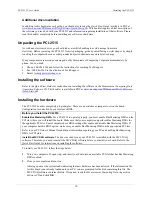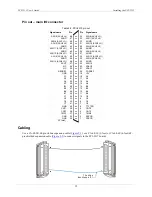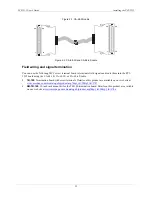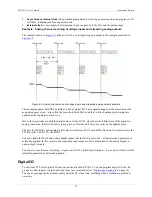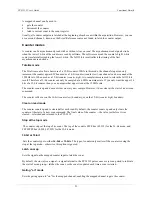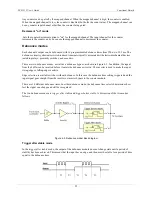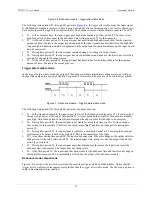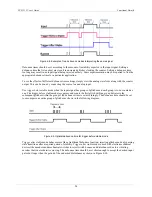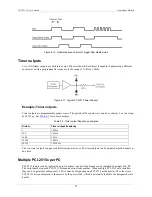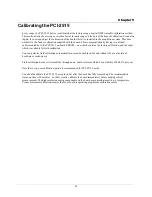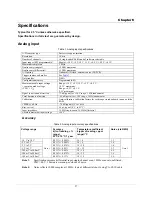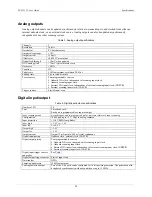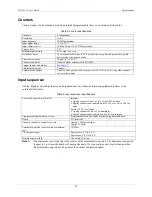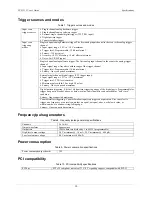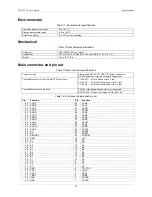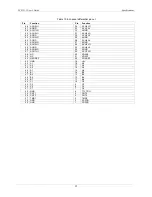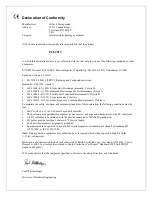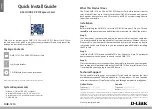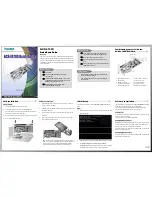
PCI-2515 User's Guide
Functional Details
18
Digital input scanning
Digital input ports can be read asynchronously before, during, or after an analog input scan.
Digital input ports can be part of the scan group and
scanned along with analog input channels
. Two
synchronous modes are supported when digital inputs are scanned along with analog inputs.
In both modes, adding digital input scans has no affect on the analog scan rate limitations.
If no analog inputs are being scanned, the digital inputs can be scanned at up to 12 MHz.
Digital outputs and pattern generation
Digital outputs can be updated asynchronously at anytime before, during, or after an acquisition. You can use
two of the 8-bit ports to generate a digital pattern at up to 12 MHz. The PCI-2515 supports digital pattern
generation with bus mastering DMA. The digital pattern can be read from PC RAM.
Digital pattern generation is clocked using an internal clock. The on-board programmable clock generates
updates ranging from once every 1 second to 1 MHz, independent of any acquisition rate.
Triggering
Triggering can be the most critical aspect of a data acquisition application. The PCI-2515 supports the
following trigger modes to accommodate certain measurement situations.
Hardware analog triggering
The PCI-2515 uses true analog triggering in which the trigger level you program sets an analog DAC, which is
then compared in hardware to the analog input level on the selected channel. This guarantees an analog trigger
latency that is less than 1 µs.
You can select any analog channel as the trigger channel, but the selected channel must be the first channel in
the scan. You can program the trigger level, the rising or falling edge, and hysteresis.
Concerning hardware analog level trigger and comparator change state
When analog input voltage starts near the trigger level, and you are performing a rising or falling] hardware
analog level trigger, the analog level comparator may have already tripped before the sweep was enabled. If this
is the case, the circuit waits for the comparator to change state. However, since the comparator has already
changed state, the circuit does not see the transition.
To resolve this problem, do the following:
1.
Set the analog level trigger to the threshold you want.
2.
Apply an analog input signal that is
more than
2.5% of the full-scale range
away from the desired
threshold
. This ensures that the comparator is in the proper state at the beginning of the acquisition.
3.
Bring the analog input signal toward the desired threshold. When the input signal is at the threshold (±
some tolerance) the sweep will be triggered.
4.
Before re-arming the trigger, again move the analog input signal to a level that is more than 2.5% of the
full-scale range
away from
the desired threshold.
For example, if you are using the ±2 V full-scale range (gain = 5), and you want to trigger at +1 V on the rising
edge, you would set the analog input voltage to a start value that is less than +0.9 V (1 V – (2 V * 2 * 2.5%)).
Summary of Contents for PCI-2515
Page 1: ......


